ICT Systems Strategy and Management: Service and Product Innovation
VerifiedAdded on 2022/10/13
|17
|4077
|342
Report
AI Summary
This report explores the critical role of Information and Communication Technology (ICT) in contemporary business environments. It emphasizes the need for effective business strategies to maintain a competitive edge, particularly in light of globalization and rapid technological advancements. The report delves into various ICT strategies, including Enterprise Resource Planning (ERP), cloud computing, and Customer Relationship Management (CRM) systems, highlighting their significance in driving product and service innovation. It examines cloud computing's impact on business agility and cost reduction, CRM's role in enhancing customer relationships and driving sales, and ERP's advantages in streamlining business processes. The report also discusses the features and benefits of each system, providing insights into how businesses can leverage these technologies to adapt to changing market demands, gain a competitive advantage, and achieve superior performance. It emphasizes the importance of aligning ICT strategies with overall business goals to foster innovation and create value.

ICT Systems Strategy and Management 1
ICT SYSTEMS STRATEGY AND MANAGEMENT
by [Name]
Professor’s Name
Course Title
Course Code
City/State
Date
ICT SYSTEMS STRATEGY AND MANAGEMENT
by [Name]
Professor’s Name
Course Title
Course Code
City/State
Date
Secure Best Marks with AI Grader
Need help grading? Try our AI Grader for instant feedback on your assignments.
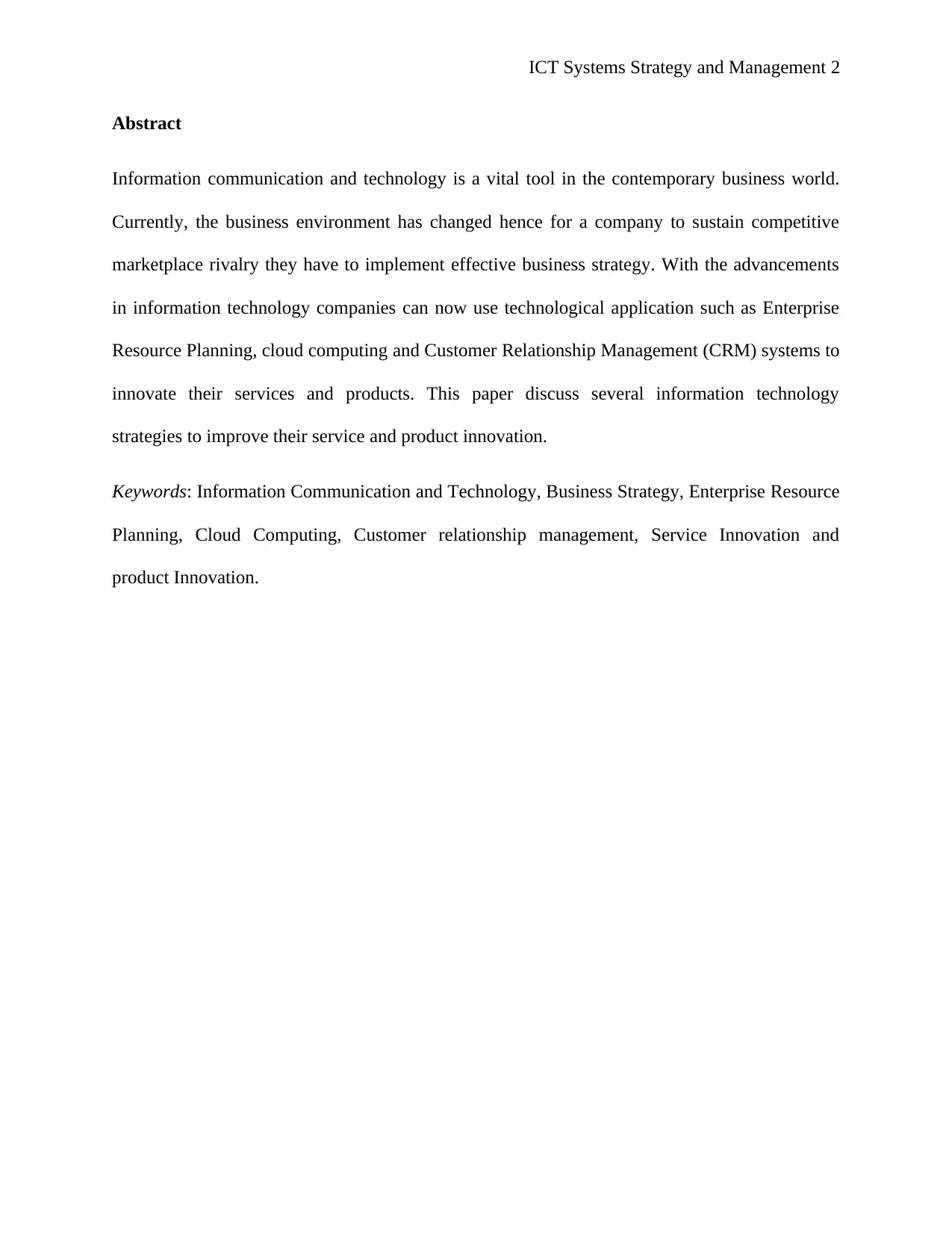
ICT Systems Strategy and Management 2
Abstract
Information communication and technology is a vital tool in the contemporary business world.
Currently, the business environment has changed hence for a company to sustain competitive
marketplace rivalry they have to implement effective business strategy. With the advancements
in information technology companies can now use technological application such as Enterprise
Resource Planning, cloud computing and Customer Relationship Management (CRM) systems to
innovate their services and products. This paper discuss several information technology
strategies to improve their service and product innovation.
Keywords: Information Communication and Technology, Business Strategy, Enterprise Resource
Planning, Cloud Computing, Customer relationship management, Service Innovation and
product Innovation.
Abstract
Information communication and technology is a vital tool in the contemporary business world.
Currently, the business environment has changed hence for a company to sustain competitive
marketplace rivalry they have to implement effective business strategy. With the advancements
in information technology companies can now use technological application such as Enterprise
Resource Planning, cloud computing and Customer Relationship Management (CRM) systems to
innovate their services and products. This paper discuss several information technology
strategies to improve their service and product innovation.
Keywords: Information Communication and Technology, Business Strategy, Enterprise Resource
Planning, Cloud Computing, Customer relationship management, Service Innovation and
product Innovation.
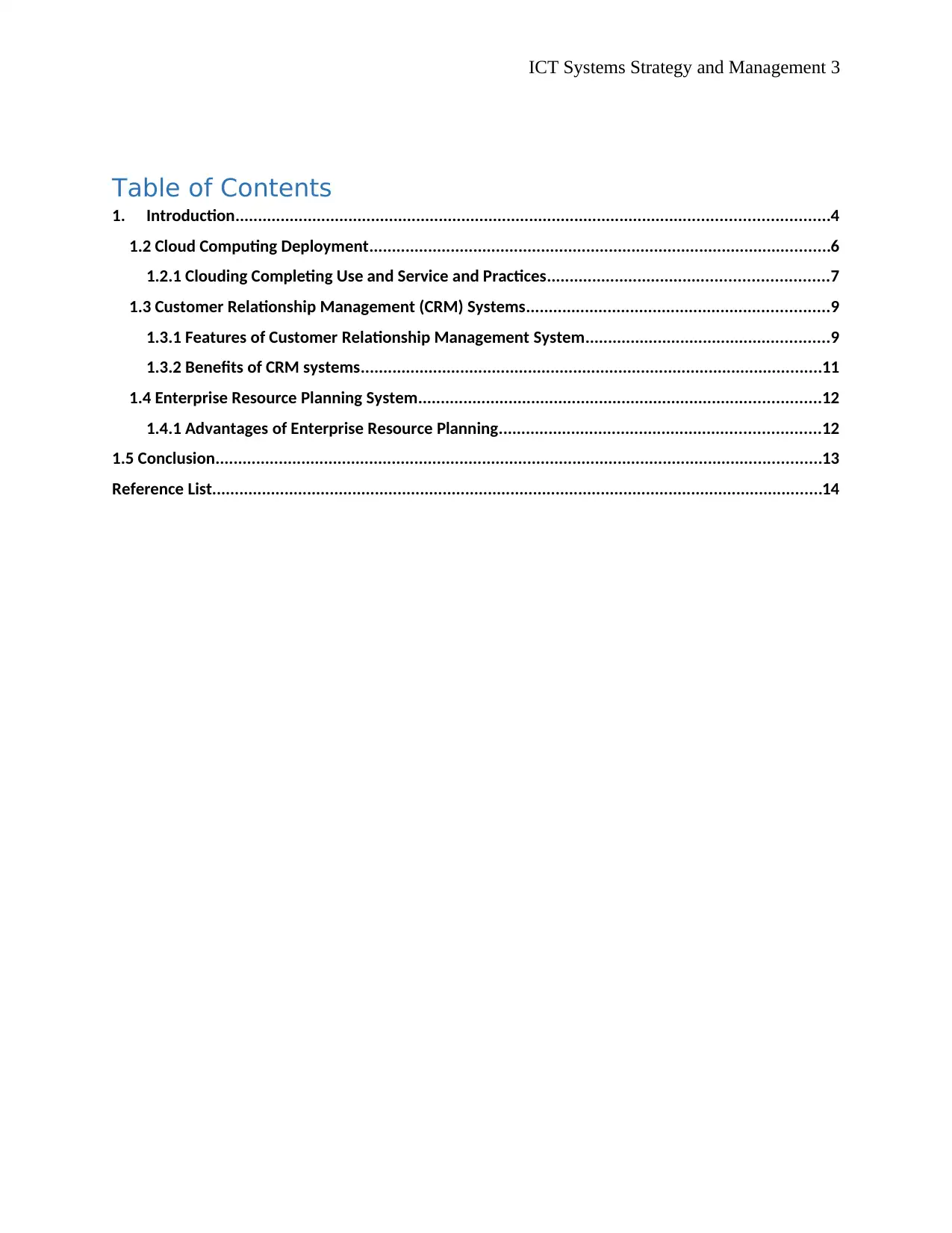
ICT Systems Strategy and Management 3
Table of Contents
1. Introduction...................................................................................................................................4
1.2 Cloud Computing Deployment......................................................................................................6
1.2.1 Clouding Completing Use and Service and Practices..............................................................7
1.3 Customer Relationship Management (CRM) Systems...................................................................9
1.3.1 Features of Customer Relationship Management System......................................................9
1.3.2 Benefits of CRM systems......................................................................................................11
1.4 Enterprise Resource Planning System.........................................................................................12
1.4.1 Advantages of Enterprise Resource Planning.......................................................................12
1.5 Conclusion......................................................................................................................................13
Reference List.......................................................................................................................................14
Table of Contents
1. Introduction...................................................................................................................................4
1.2 Cloud Computing Deployment......................................................................................................6
1.2.1 Clouding Completing Use and Service and Practices..............................................................7
1.3 Customer Relationship Management (CRM) Systems...................................................................9
1.3.1 Features of Customer Relationship Management System......................................................9
1.3.2 Benefits of CRM systems......................................................................................................11
1.4 Enterprise Resource Planning System.........................................................................................12
1.4.1 Advantages of Enterprise Resource Planning.......................................................................12
1.5 Conclusion......................................................................................................................................13
Reference List.......................................................................................................................................14
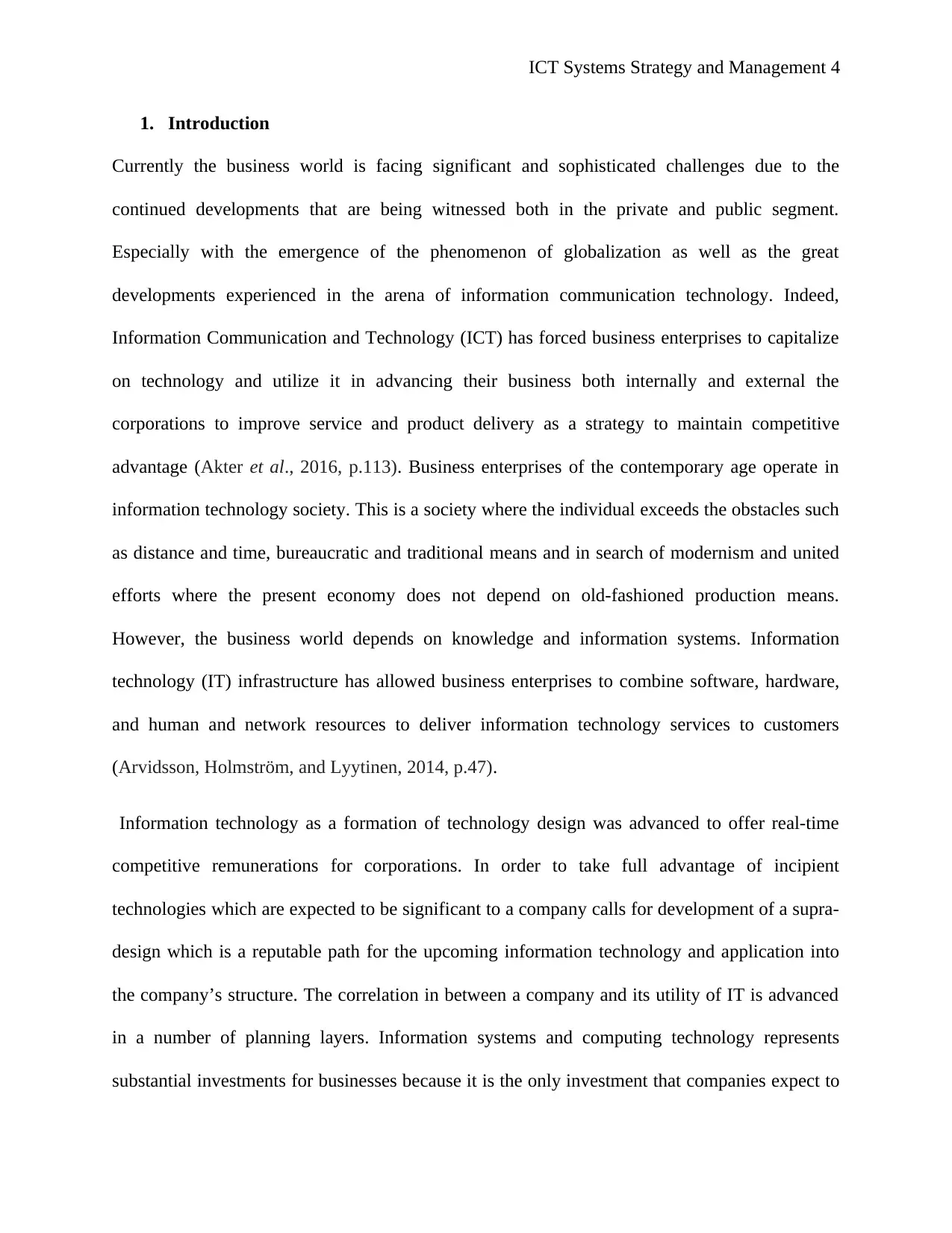
ICT Systems Strategy and Management 4
1. Introduction
Currently the business world is facing significant and sophisticated challenges due to the
continued developments that are being witnessed both in the private and public segment.
Especially with the emergence of the phenomenon of globalization as well as the great
developments experienced in the arena of information communication technology. Indeed,
Information Communication and Technology (ICT) has forced business enterprises to capitalize
on technology and utilize it in advancing their business both internally and external the
corporations to improve service and product delivery as a strategy to maintain competitive
advantage (Akter et al., 2016, p.113). Business enterprises of the contemporary age operate in
information technology society. This is a society where the individual exceeds the obstacles such
as distance and time, bureaucratic and traditional means and in search of modernism and united
efforts where the present economy does not depend on old-fashioned production means.
However, the business world depends on knowledge and information systems. Information
technology (IT) infrastructure has allowed business enterprises to combine software, hardware,
and human and network resources to deliver information technology services to customers
(Arvidsson, Holmström, and Lyytinen, 2014, p.47).
Information technology as a formation of technology design was advanced to offer real-time
competitive remunerations for corporations. In order to take full advantage of incipient
technologies which are expected to be significant to a company calls for development of a supra-
design which is a reputable path for the upcoming information technology and application into
the company’s structure. The correlation in between a company and its utility of IT is advanced
in a number of planning layers. Information systems and computing technology represents
substantial investments for businesses because it is the only investment that companies expect to
1. Introduction
Currently the business world is facing significant and sophisticated challenges due to the
continued developments that are being witnessed both in the private and public segment.
Especially with the emergence of the phenomenon of globalization as well as the great
developments experienced in the arena of information communication technology. Indeed,
Information Communication and Technology (ICT) has forced business enterprises to capitalize
on technology and utilize it in advancing their business both internally and external the
corporations to improve service and product delivery as a strategy to maintain competitive
advantage (Akter et al., 2016, p.113). Business enterprises of the contemporary age operate in
information technology society. This is a society where the individual exceeds the obstacles such
as distance and time, bureaucratic and traditional means and in search of modernism and united
efforts where the present economy does not depend on old-fashioned production means.
However, the business world depends on knowledge and information systems. Information
technology (IT) infrastructure has allowed business enterprises to combine software, hardware,
and human and network resources to deliver information technology services to customers
(Arvidsson, Holmström, and Lyytinen, 2014, p.47).
Information technology as a formation of technology design was advanced to offer real-time
competitive remunerations for corporations. In order to take full advantage of incipient
technologies which are expected to be significant to a company calls for development of a supra-
design which is a reputable path for the upcoming information technology and application into
the company’s structure. The correlation in between a company and its utility of IT is advanced
in a number of planning layers. Information systems and computing technology represents
substantial investments for businesses because it is the only investment that companies expect to
Secure Best Marks with AI Grader
Need help grading? Try our AI Grader for instant feedback on your assignments.
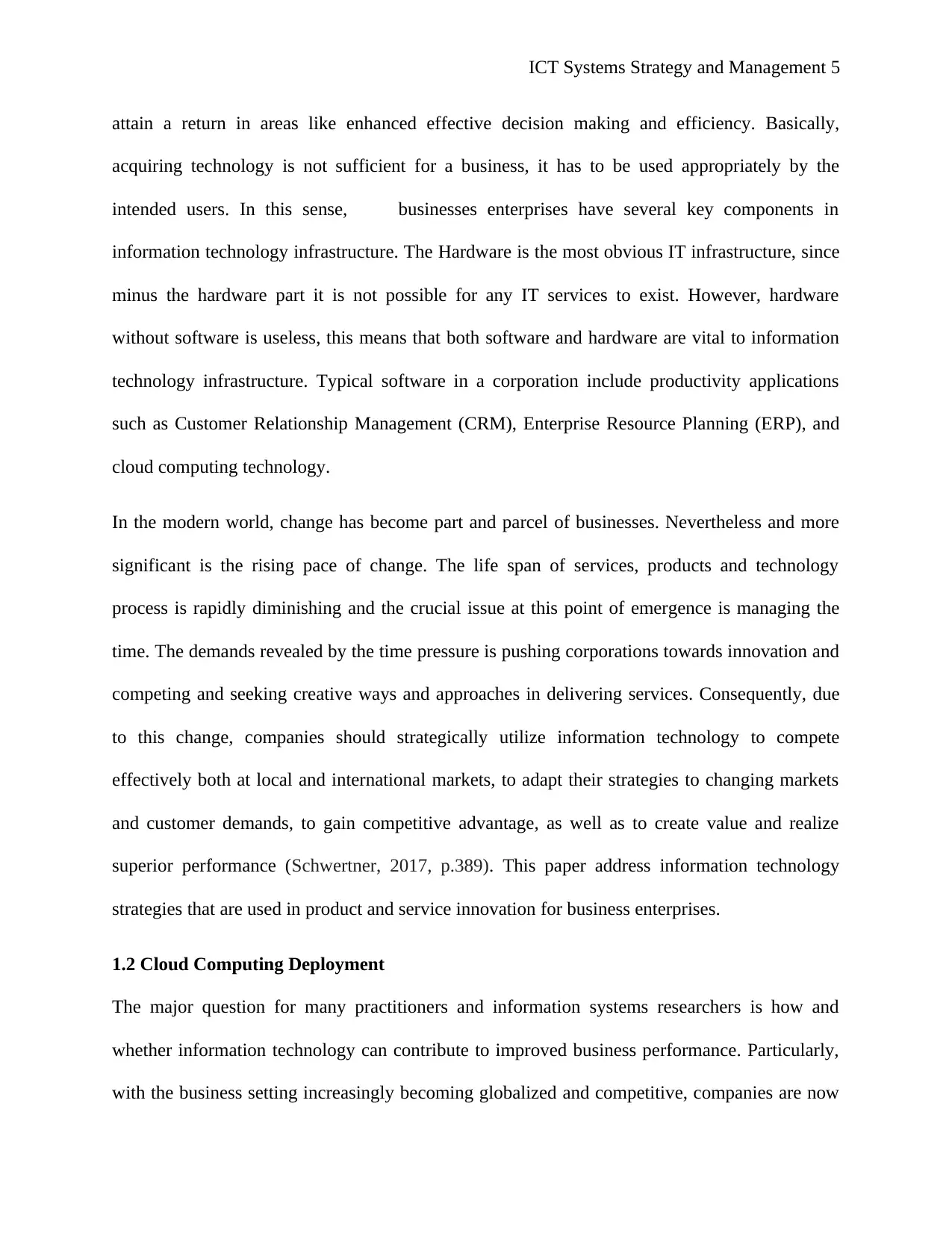
ICT Systems Strategy and Management 5
attain a return in areas like enhanced effective decision making and efficiency. Basically,
acquiring technology is not sufficient for a business, it has to be used appropriately by the
intended users. In this sense, businesses enterprises have several key components in
information technology infrastructure. The Hardware is the most obvious IT infrastructure, since
minus the hardware part it is not possible for any IT services to exist. However, hardware
without software is useless, this means that both software and hardware are vital to information
technology infrastructure. Typical software in a corporation include productivity applications
such as Customer Relationship Management (CRM), Enterprise Resource Planning (ERP), and
cloud computing technology.
In the modern world, change has become part and parcel of businesses. Nevertheless and more
significant is the rising pace of change. The life span of services, products and technology
process is rapidly diminishing and the crucial issue at this point of emergence is managing the
time. The demands revealed by the time pressure is pushing corporations towards innovation and
competing and seeking creative ways and approaches in delivering services. Consequently, due
to this change, companies should strategically utilize information technology to compete
effectively both at local and international markets, to adapt their strategies to changing markets
and customer demands, to gain competitive advantage, as well as to create value and realize
superior performance (Schwertner, 2017, p.389). This paper address information technology
strategies that are used in product and service innovation for business enterprises.
1.2 Cloud Computing Deployment
The major question for many practitioners and information systems researchers is how and
whether information technology can contribute to improved business performance. Particularly,
with the business setting increasingly becoming globalized and competitive, companies are now
attain a return in areas like enhanced effective decision making and efficiency. Basically,
acquiring technology is not sufficient for a business, it has to be used appropriately by the
intended users. In this sense, businesses enterprises have several key components in
information technology infrastructure. The Hardware is the most obvious IT infrastructure, since
minus the hardware part it is not possible for any IT services to exist. However, hardware
without software is useless, this means that both software and hardware are vital to information
technology infrastructure. Typical software in a corporation include productivity applications
such as Customer Relationship Management (CRM), Enterprise Resource Planning (ERP), and
cloud computing technology.
In the modern world, change has become part and parcel of businesses. Nevertheless and more
significant is the rising pace of change. The life span of services, products and technology
process is rapidly diminishing and the crucial issue at this point of emergence is managing the
time. The demands revealed by the time pressure is pushing corporations towards innovation and
competing and seeking creative ways and approaches in delivering services. Consequently, due
to this change, companies should strategically utilize information technology to compete
effectively both at local and international markets, to adapt their strategies to changing markets
and customer demands, to gain competitive advantage, as well as to create value and realize
superior performance (Schwertner, 2017, p.389). This paper address information technology
strategies that are used in product and service innovation for business enterprises.
1.2 Cloud Computing Deployment
The major question for many practitioners and information systems researchers is how and
whether information technology can contribute to improved business performance. Particularly,
with the business setting increasingly becoming globalized and competitive, companies are now
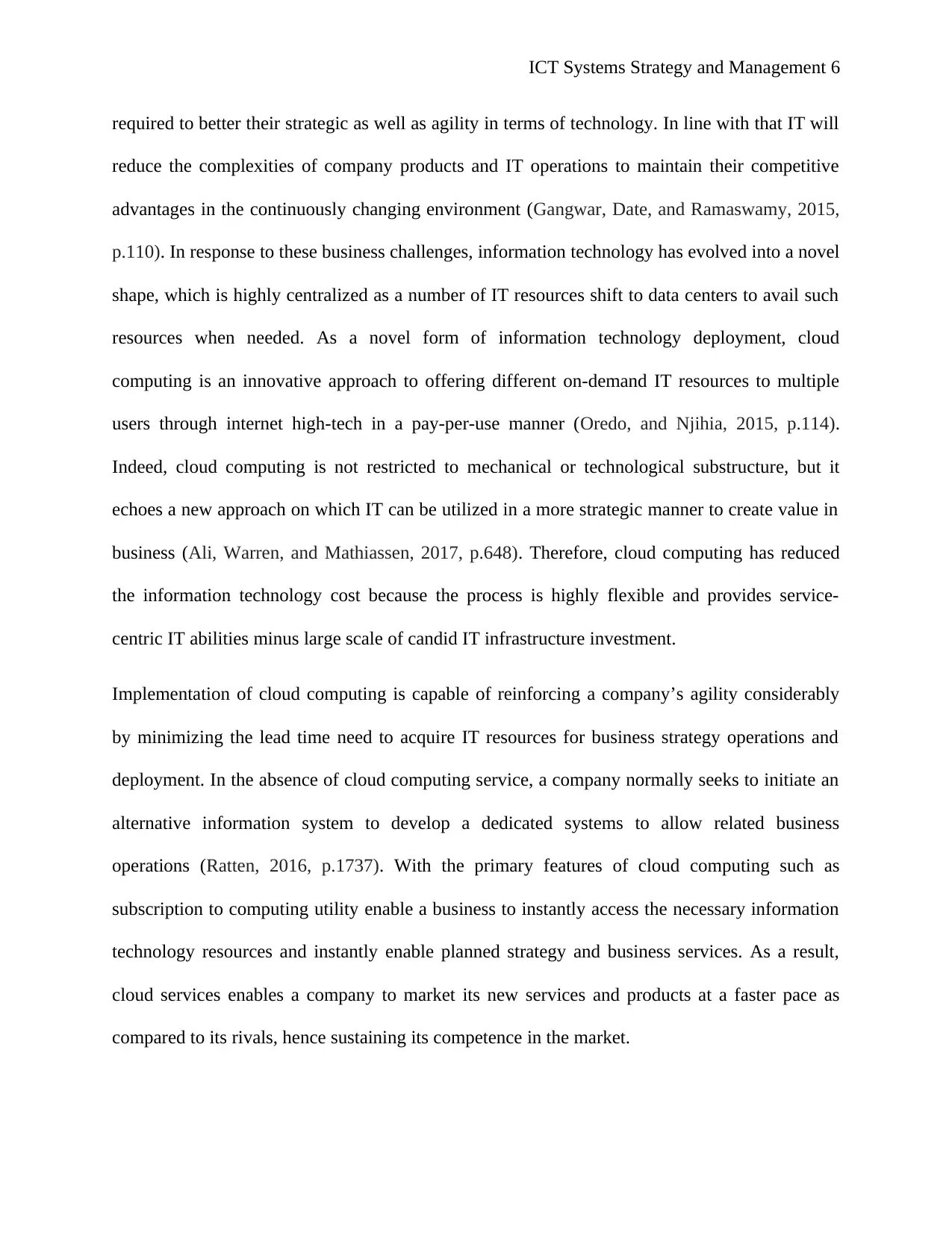
ICT Systems Strategy and Management 6
required to better their strategic as well as agility in terms of technology. In line with that IT will
reduce the complexities of company products and IT operations to maintain their competitive
advantages in the continuously changing environment (Gangwar, Date, and Ramaswamy, 2015,
p.110). In response to these business challenges, information technology has evolved into a novel
shape, which is highly centralized as a number of IT resources shift to data centers to avail such
resources when needed. As a novel form of information technology deployment, cloud
computing is an innovative approach to offering different on-demand IT resources to multiple
users through internet high-tech in a pay-per-use manner (Oredo, and Njihia, 2015, p.114).
Indeed, cloud computing is not restricted to mechanical or technological substructure, but it
echoes a new approach on which IT can be utilized in a more strategic manner to create value in
business (Ali, Warren, and Mathiassen, 2017, p.648). Therefore, cloud computing has reduced
the information technology cost because the process is highly flexible and provides service-
centric IT abilities minus large scale of candid IT infrastructure investment.
Implementation of cloud computing is capable of reinforcing a company’s agility considerably
by minimizing the lead time need to acquire IT resources for business strategy operations and
deployment. In the absence of cloud computing service, a company normally seeks to initiate an
alternative information system to develop a dedicated systems to allow related business
operations (Ratten, 2016, p.1737). With the primary features of cloud computing such as
subscription to computing utility enable a business to instantly access the necessary information
technology resources and instantly enable planned strategy and business services. As a result,
cloud services enables a company to market its new services and products at a faster pace as
compared to its rivals, hence sustaining its competence in the market.
required to better their strategic as well as agility in terms of technology. In line with that IT will
reduce the complexities of company products and IT operations to maintain their competitive
advantages in the continuously changing environment (Gangwar, Date, and Ramaswamy, 2015,
p.110). In response to these business challenges, information technology has evolved into a novel
shape, which is highly centralized as a number of IT resources shift to data centers to avail such
resources when needed. As a novel form of information technology deployment, cloud
computing is an innovative approach to offering different on-demand IT resources to multiple
users through internet high-tech in a pay-per-use manner (Oredo, and Njihia, 2015, p.114).
Indeed, cloud computing is not restricted to mechanical or technological substructure, but it
echoes a new approach on which IT can be utilized in a more strategic manner to create value in
business (Ali, Warren, and Mathiassen, 2017, p.648). Therefore, cloud computing has reduced
the information technology cost because the process is highly flexible and provides service-
centric IT abilities minus large scale of candid IT infrastructure investment.
Implementation of cloud computing is capable of reinforcing a company’s agility considerably
by minimizing the lead time need to acquire IT resources for business strategy operations and
deployment. In the absence of cloud computing service, a company normally seeks to initiate an
alternative information system to develop a dedicated systems to allow related business
operations (Ratten, 2016, p.1737). With the primary features of cloud computing such as
subscription to computing utility enable a business to instantly access the necessary information
technology resources and instantly enable planned strategy and business services. As a result,
cloud services enables a company to market its new services and products at a faster pace as
compared to its rivals, hence sustaining its competence in the market.
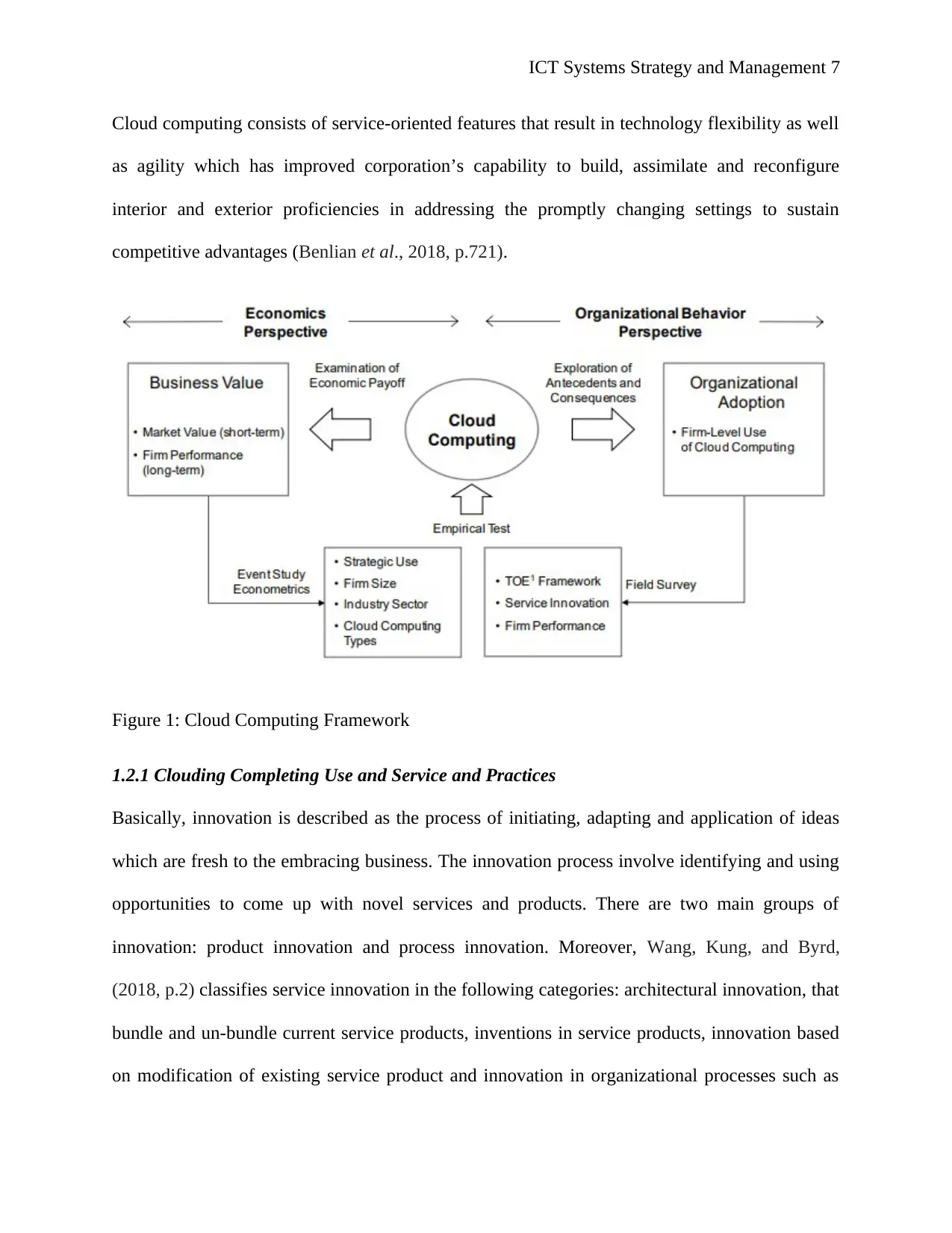
ICT Systems Strategy and Management 7
Cloud computing consists of service-oriented features that result in technology flexibility as well
as agility which has improved corporation’s capability to build, assimilate and reconfigure
interior and exterior proficiencies in addressing the promptly changing settings to sustain
competitive advantages (Benlian et al., 2018, p.721).
Figure 1: Cloud Computing Framework
1.2.1 Clouding Completing Use and Service and Practices
Basically, innovation is described as the process of initiating, adapting and application of ideas
which are fresh to the embracing business. The innovation process involve identifying and using
opportunities to come up with novel services and products. There are two main groups of
innovation: product innovation and process innovation. Moreover, Wang, Kung, and Byrd,
(2018, p.2) classifies service innovation in the following categories: architectural innovation, that
bundle and un-bundle current service products, inventions in service products, innovation based
on modification of existing service product and innovation in organizational processes such as
Cloud computing consists of service-oriented features that result in technology flexibility as well
as agility which has improved corporation’s capability to build, assimilate and reconfigure
interior and exterior proficiencies in addressing the promptly changing settings to sustain
competitive advantages (Benlian et al., 2018, p.721).
Figure 1: Cloud Computing Framework
1.2.1 Clouding Completing Use and Service and Practices
Basically, innovation is described as the process of initiating, adapting and application of ideas
which are fresh to the embracing business. The innovation process involve identifying and using
opportunities to come up with novel services and products. There are two main groups of
innovation: product innovation and process innovation. Moreover, Wang, Kung, and Byrd,
(2018, p.2) classifies service innovation in the following categories: architectural innovation, that
bundle and un-bundle current service products, inventions in service products, innovation based
on modification of existing service product and innovation in organizational processes such as
Paraphrase This Document
Need a fresh take? Get an instant paraphrase of this document with our AI Paraphraser
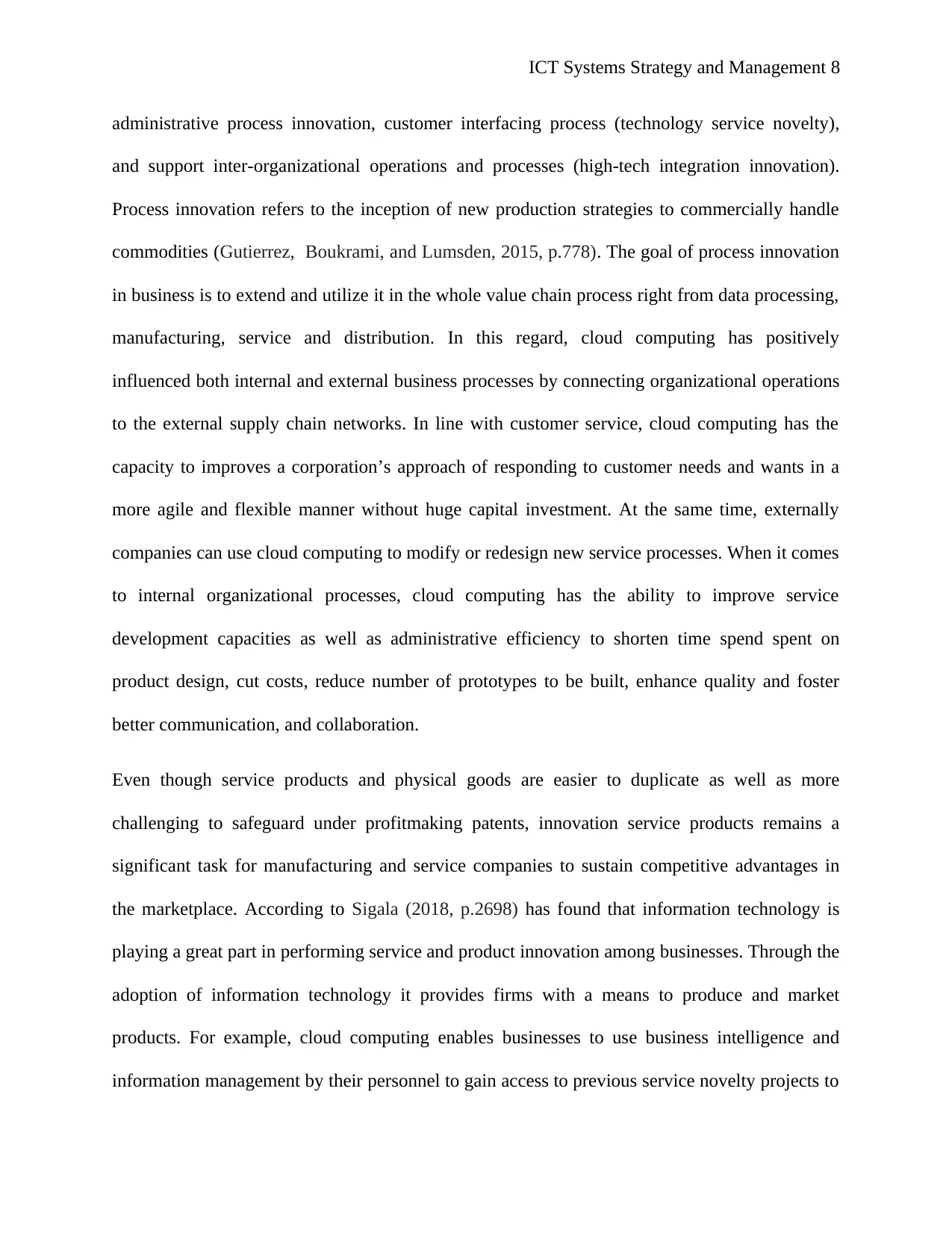
ICT Systems Strategy and Management 8
administrative process innovation, customer interfacing process (technology service novelty),
and support inter-organizational operations and processes (high-tech integration innovation).
Process innovation refers to the inception of new production strategies to commercially handle
commodities (Gutierrez, Boukrami, and Lumsden, 2015, p.778). The goal of process innovation
in business is to extend and utilize it in the whole value chain process right from data processing,
manufacturing, service and distribution. In this regard, cloud computing has positively
influenced both internal and external business processes by connecting organizational operations
to the external supply chain networks. In line with customer service, cloud computing has the
capacity to improves a corporation’s approach of responding to customer needs and wants in a
more agile and flexible manner without huge capital investment. At the same time, externally
companies can use cloud computing to modify or redesign new service processes. When it comes
to internal organizational processes, cloud computing has the ability to improve service
development capacities as well as administrative efficiency to shorten time spend spent on
product design, cut costs, reduce number of prototypes to be built, enhance quality and foster
better communication, and collaboration.
Even though service products and physical goods are easier to duplicate as well as more
challenging to safeguard under profitmaking patents, innovation service products remains a
significant task for manufacturing and service companies to sustain competitive advantages in
the marketplace. According to Sigala (2018, p.2698) has found that information technology is
playing a great part in performing service and product innovation among businesses. Through the
adoption of information technology it provides firms with a means to produce and market
products. For example, cloud computing enables businesses to use business intelligence and
information management by their personnel to gain access to previous service novelty projects to
administrative process innovation, customer interfacing process (technology service novelty),
and support inter-organizational operations and processes (high-tech integration innovation).
Process innovation refers to the inception of new production strategies to commercially handle
commodities (Gutierrez, Boukrami, and Lumsden, 2015, p.778). The goal of process innovation
in business is to extend and utilize it in the whole value chain process right from data processing,
manufacturing, service and distribution. In this regard, cloud computing has positively
influenced both internal and external business processes by connecting organizational operations
to the external supply chain networks. In line with customer service, cloud computing has the
capacity to improves a corporation’s approach of responding to customer needs and wants in a
more agile and flexible manner without huge capital investment. At the same time, externally
companies can use cloud computing to modify or redesign new service processes. When it comes
to internal organizational processes, cloud computing has the ability to improve service
development capacities as well as administrative efficiency to shorten time spend spent on
product design, cut costs, reduce number of prototypes to be built, enhance quality and foster
better communication, and collaboration.
Even though service products and physical goods are easier to duplicate as well as more
challenging to safeguard under profitmaking patents, innovation service products remains a
significant task for manufacturing and service companies to sustain competitive advantages in
the marketplace. According to Sigala (2018, p.2698) has found that information technology is
playing a great part in performing service and product innovation among businesses. Through the
adoption of information technology it provides firms with a means to produce and market
products. For example, cloud computing enables businesses to use business intelligence and
information management by their personnel to gain access to previous service novelty projects to
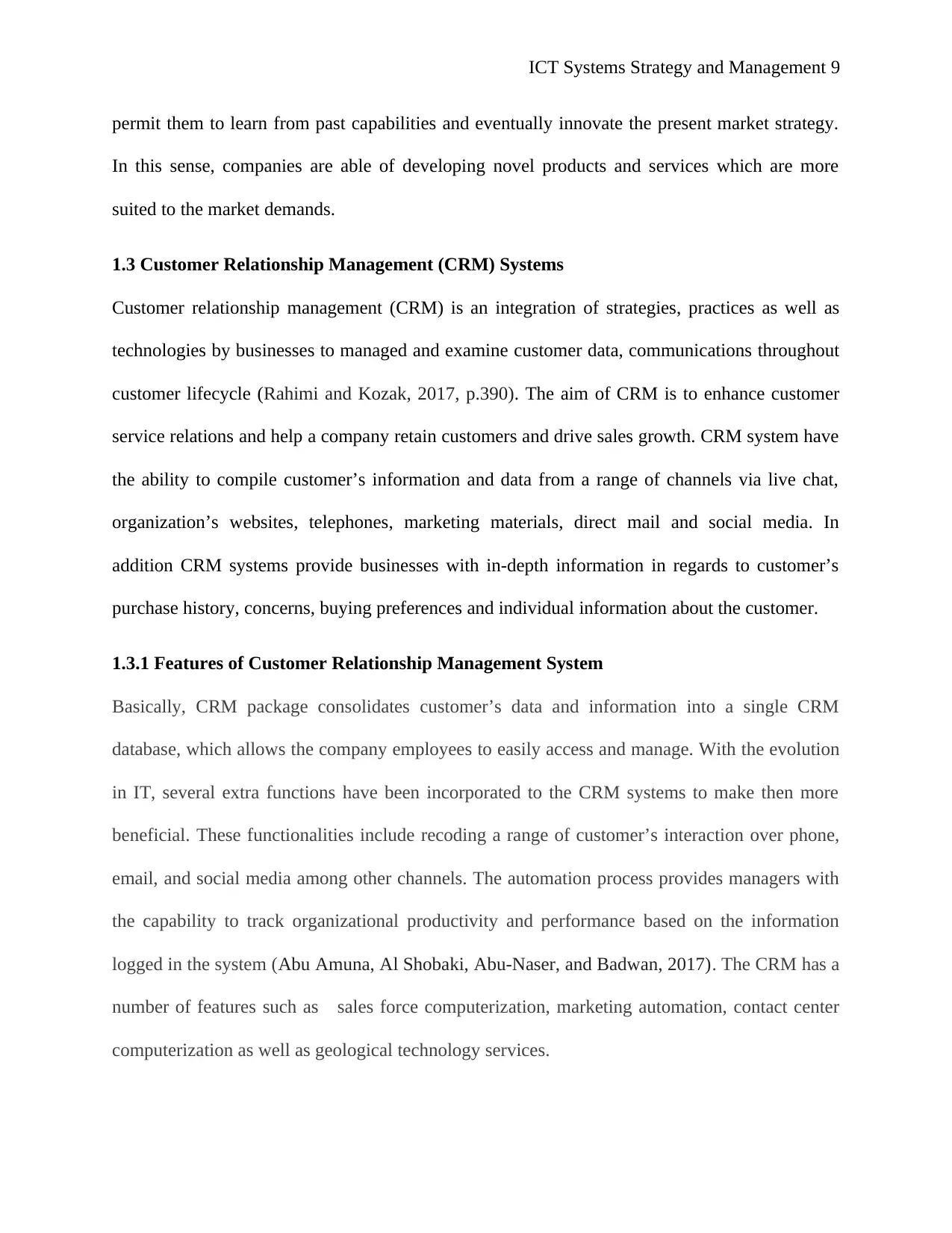
ICT Systems Strategy and Management 9
permit them to learn from past capabilities and eventually innovate the present market strategy.
In this sense, companies are able of developing novel products and services which are more
suited to the market demands.
1.3 Customer Relationship Management (CRM) Systems
Customer relationship management (CRM) is an integration of strategies, practices as well as
technologies by businesses to managed and examine customer data, communications throughout
customer lifecycle (Rahimi and Kozak, 2017, p.390). The aim of CRM is to enhance customer
service relations and help a company retain customers and drive sales growth. CRM system have
the ability to compile customer’s information and data from a range of channels via live chat,
organization’s websites, telephones, marketing materials, direct mail and social media. In
addition CRM systems provide businesses with in-depth information in regards to customer’s
purchase history, concerns, buying preferences and individual information about the customer.
1.3.1 Features of Customer Relationship Management System
Basically, CRM package consolidates customer’s data and information into a single CRM
database, which allows the company employees to easily access and manage. With the evolution
in IT, several extra functions have been incorporated to the CRM systems to make then more
beneficial. These functionalities include recoding a range of customer’s interaction over phone,
email, and social media among other channels. The automation process provides managers with
the capability to track organizational productivity and performance based on the information
logged in the system (Abu Amuna, Al Shobaki, Abu-Naser, and Badwan, 2017). The CRM has a
number of features such as sales force computerization, marketing automation, contact center
computerization as well as geological technology services.
permit them to learn from past capabilities and eventually innovate the present market strategy.
In this sense, companies are able of developing novel products and services which are more
suited to the market demands.
1.3 Customer Relationship Management (CRM) Systems
Customer relationship management (CRM) is an integration of strategies, practices as well as
technologies by businesses to managed and examine customer data, communications throughout
customer lifecycle (Rahimi and Kozak, 2017, p.390). The aim of CRM is to enhance customer
service relations and help a company retain customers and drive sales growth. CRM system have
the ability to compile customer’s information and data from a range of channels via live chat,
organization’s websites, telephones, marketing materials, direct mail and social media. In
addition CRM systems provide businesses with in-depth information in regards to customer’s
purchase history, concerns, buying preferences and individual information about the customer.
1.3.1 Features of Customer Relationship Management System
Basically, CRM package consolidates customer’s data and information into a single CRM
database, which allows the company employees to easily access and manage. With the evolution
in IT, several extra functions have been incorporated to the CRM systems to make then more
beneficial. These functionalities include recoding a range of customer’s interaction over phone,
email, and social media among other channels. The automation process provides managers with
the capability to track organizational productivity and performance based on the information
logged in the system (Abu Amuna, Al Shobaki, Abu-Naser, and Badwan, 2017). The CRM has a
number of features such as sales force computerization, marketing automation, contact center
computerization as well as geological technology services.
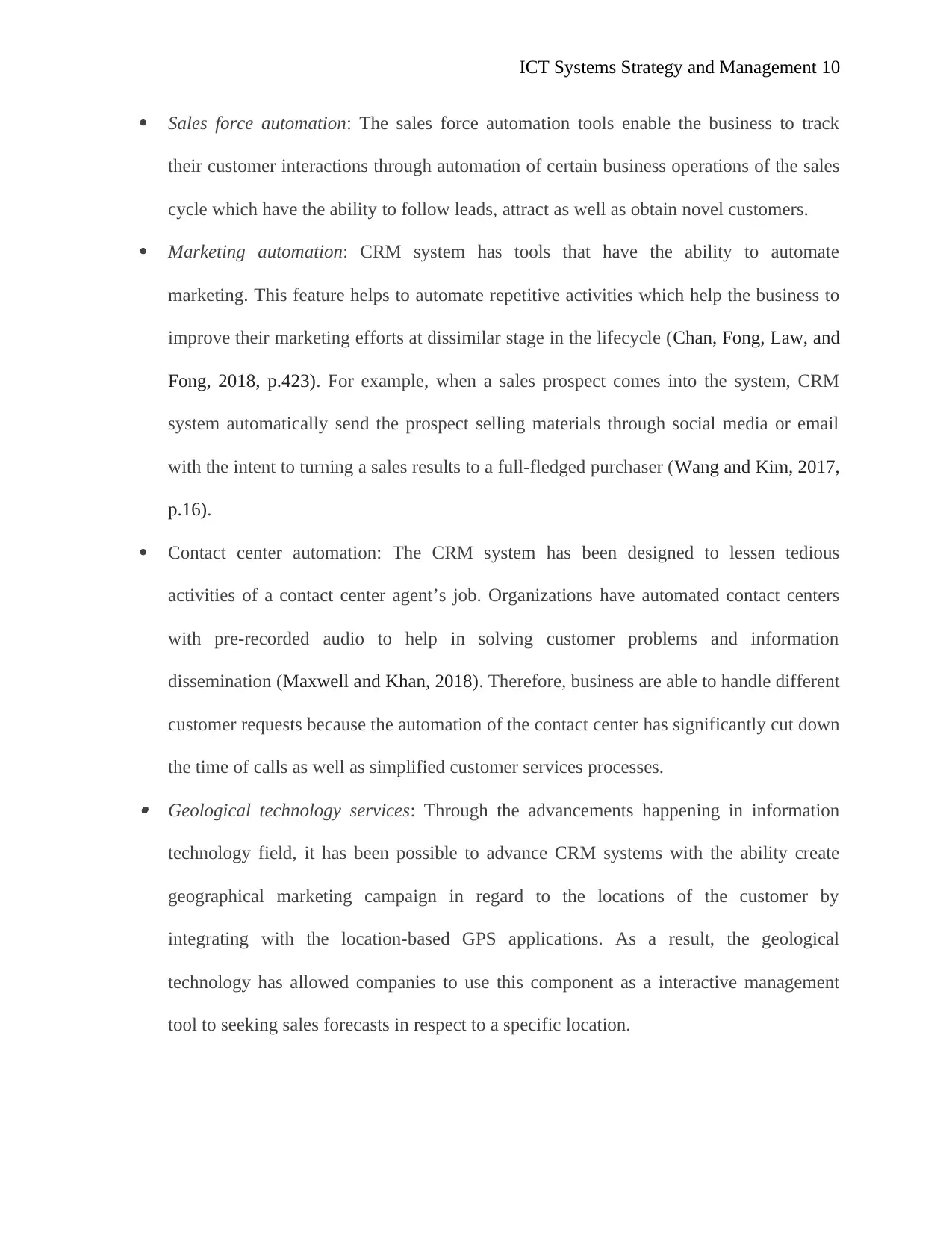
ICT Systems Strategy and Management 10
Sales force automation: The sales force automation tools enable the business to track
their customer interactions through automation of certain business operations of the sales
cycle which have the ability to follow leads, attract as well as obtain novel customers.
Marketing automation: CRM system has tools that have the ability to automate
marketing. This feature helps to automate repetitive activities which help the business to
improve their marketing efforts at dissimilar stage in the lifecycle (Chan, Fong, Law, and
Fong, 2018, p.423). For example, when a sales prospect comes into the system, CRM
system automatically send the prospect selling materials through social media or email
with the intent to turning a sales results to a full-fledged purchaser (Wang and Kim, 2017,
p.16).
Contact center automation: The CRM system has been designed to lessen tedious
activities of a contact center agent’s job. Organizations have automated contact centers
with pre-recorded audio to help in solving customer problems and information
dissemination (Maxwell and Khan, 2018). Therefore, business are able to handle different
customer requests because the automation of the contact center has significantly cut down
the time of calls as well as simplified customer services processes. Geological technology services: Through the advancements happening in information
technology field, it has been possible to advance CRM systems with the ability create
geographical marketing campaign in regard to the locations of the customer by
integrating with the location-based GPS applications. As a result, the geological
technology has allowed companies to use this component as a interactive management
tool to seeking sales forecasts in respect to a specific location.
Sales force automation: The sales force automation tools enable the business to track
their customer interactions through automation of certain business operations of the sales
cycle which have the ability to follow leads, attract as well as obtain novel customers.
Marketing automation: CRM system has tools that have the ability to automate
marketing. This feature helps to automate repetitive activities which help the business to
improve their marketing efforts at dissimilar stage in the lifecycle (Chan, Fong, Law, and
Fong, 2018, p.423). For example, when a sales prospect comes into the system, CRM
system automatically send the prospect selling materials through social media or email
with the intent to turning a sales results to a full-fledged purchaser (Wang and Kim, 2017,
p.16).
Contact center automation: The CRM system has been designed to lessen tedious
activities of a contact center agent’s job. Organizations have automated contact centers
with pre-recorded audio to help in solving customer problems and information
dissemination (Maxwell and Khan, 2018). Therefore, business are able to handle different
customer requests because the automation of the contact center has significantly cut down
the time of calls as well as simplified customer services processes. Geological technology services: Through the advancements happening in information
technology field, it has been possible to advance CRM systems with the ability create
geographical marketing campaign in regard to the locations of the customer by
integrating with the location-based GPS applications. As a result, the geological
technology has allowed companies to use this component as a interactive management
tool to seeking sales forecasts in respect to a specific location.
Secure Best Marks with AI Grader
Need help grading? Try our AI Grader for instant feedback on your assignments.
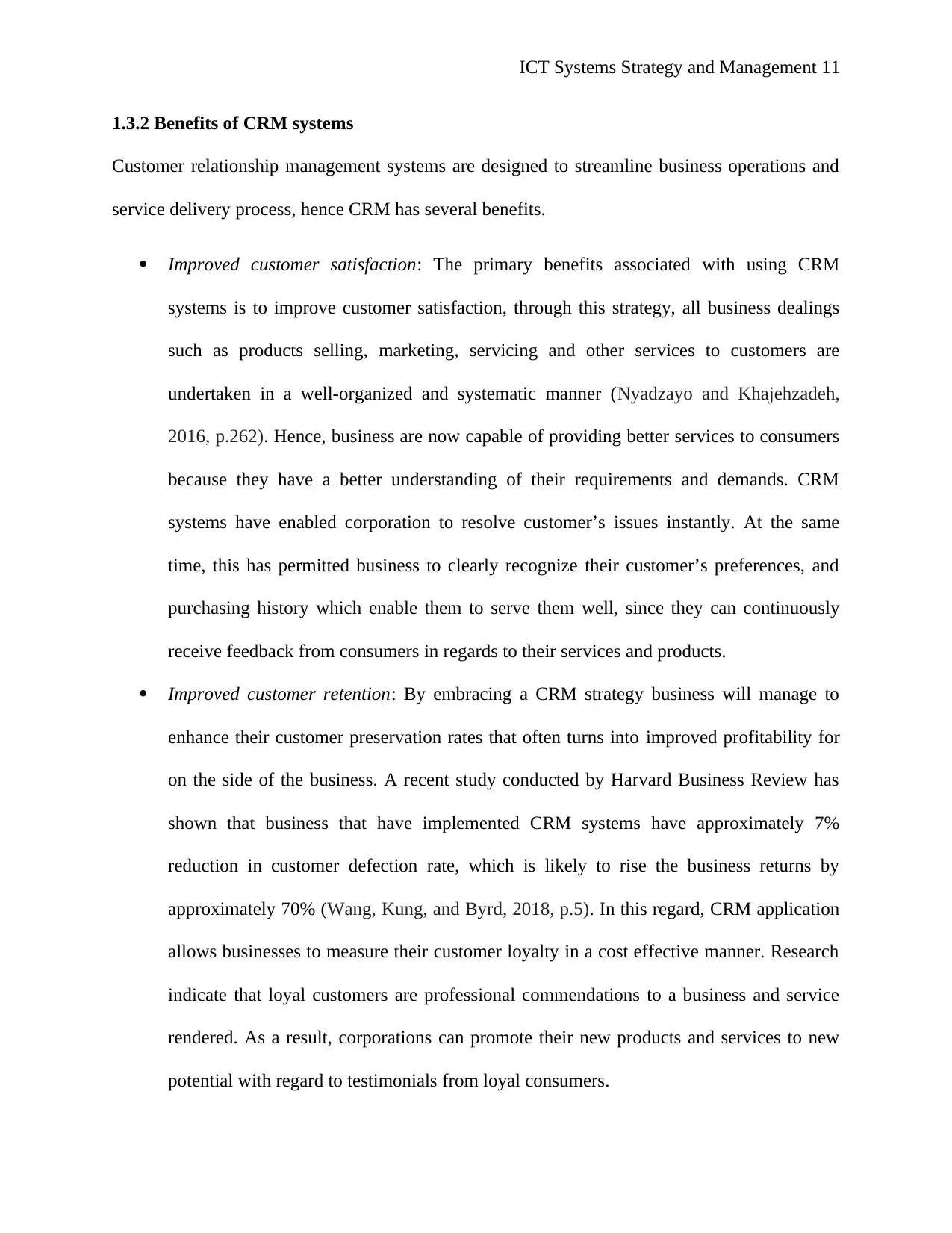
ICT Systems Strategy and Management 11
1.3.2 Benefits of CRM systems
Customer relationship management systems are designed to streamline business operations and
service delivery process, hence CRM has several benefits.
Improved customer satisfaction: The primary benefits associated with using CRM
systems is to improve customer satisfaction, through this strategy, all business dealings
such as products selling, marketing, servicing and other services to customers are
undertaken in a well-organized and systematic manner (Nyadzayo and Khajehzadeh,
2016, p.262). Hence, business are now capable of providing better services to consumers
because they have a better understanding of their requirements and demands. CRM
systems have enabled corporation to resolve customer’s issues instantly. At the same
time, this has permitted business to clearly recognize their customer’s preferences, and
purchasing history which enable them to serve them well, since they can continuously
receive feedback from consumers in regards to their services and products.
Improved customer retention: By embracing a CRM strategy business will manage to
enhance their customer preservation rates that often turns into improved profitability for
on the side of the business. A recent study conducted by Harvard Business Review has
shown that business that have implemented CRM systems have approximately 7%
reduction in customer defection rate, which is likely to rise the business returns by
approximately 70% (Wang, Kung, and Byrd, 2018, p.5). In this regard, CRM application
allows businesses to measure their customer loyalty in a cost effective manner. Research
indicate that loyal customers are professional commendations to a business and service
rendered. As a result, corporations can promote their new products and services to new
potential with regard to testimonials from loyal consumers.
1.3.2 Benefits of CRM systems
Customer relationship management systems are designed to streamline business operations and
service delivery process, hence CRM has several benefits.
Improved customer satisfaction: The primary benefits associated with using CRM
systems is to improve customer satisfaction, through this strategy, all business dealings
such as products selling, marketing, servicing and other services to customers are
undertaken in a well-organized and systematic manner (Nyadzayo and Khajehzadeh,
2016, p.262). Hence, business are now capable of providing better services to consumers
because they have a better understanding of their requirements and demands. CRM
systems have enabled corporation to resolve customer’s issues instantly. At the same
time, this has permitted business to clearly recognize their customer’s preferences, and
purchasing history which enable them to serve them well, since they can continuously
receive feedback from consumers in regards to their services and products.
Improved customer retention: By embracing a CRM strategy business will manage to
enhance their customer preservation rates that often turns into improved profitability for
on the side of the business. A recent study conducted by Harvard Business Review has
shown that business that have implemented CRM systems have approximately 7%
reduction in customer defection rate, which is likely to rise the business returns by
approximately 70% (Wang, Kung, and Byrd, 2018, p.5). In this regard, CRM application
allows businesses to measure their customer loyalty in a cost effective manner. Research
indicate that loyal customers are professional commendations to a business and service
rendered. As a result, corporations can promote their new products and services to new
potential with regard to testimonials from loyal consumers.
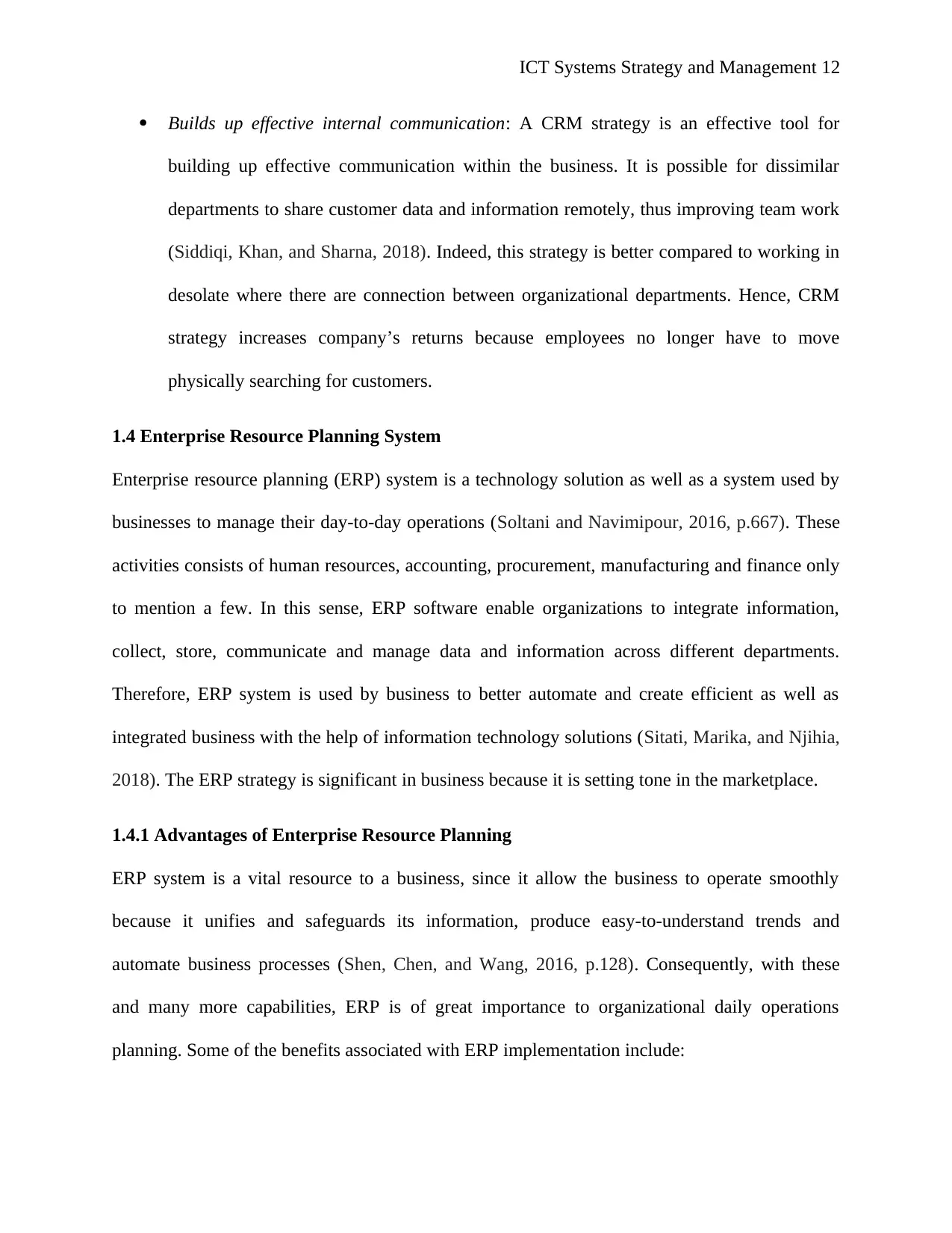
ICT Systems Strategy and Management 12
Builds up effective internal communication: A CRM strategy is an effective tool for
building up effective communication within the business. It is possible for dissimilar
departments to share customer data and information remotely, thus improving team work
(Siddiqi, Khan, and Sharna, 2018). Indeed, this strategy is better compared to working in
desolate where there are connection between organizational departments. Hence, CRM
strategy increases company’s returns because employees no longer have to move
physically searching for customers.
1.4 Enterprise Resource Planning System
Enterprise resource planning (ERP) system is a technology solution as well as a system used by
businesses to manage their day-to-day operations (Soltani and Navimipour, 2016, p.667). These
activities consists of human resources, accounting, procurement, manufacturing and finance only
to mention a few. In this sense, ERP software enable organizations to integrate information,
collect, store, communicate and manage data and information across different departments.
Therefore, ERP system is used by business to better automate and create efficient as well as
integrated business with the help of information technology solutions (Sitati, Marika, and Njihia,
2018). The ERP strategy is significant in business because it is setting tone in the marketplace.
1.4.1 Advantages of Enterprise Resource Planning
ERP system is a vital resource to a business, since it allow the business to operate smoothly
because it unifies and safeguards its information, produce easy-to-understand trends and
automate business processes (Shen, Chen, and Wang, 2016, p.128). Consequently, with these
and many more capabilities, ERP is of great importance to organizational daily operations
planning. Some of the benefits associated with ERP implementation include:
Builds up effective internal communication: A CRM strategy is an effective tool for
building up effective communication within the business. It is possible for dissimilar
departments to share customer data and information remotely, thus improving team work
(Siddiqi, Khan, and Sharna, 2018). Indeed, this strategy is better compared to working in
desolate where there are connection between organizational departments. Hence, CRM
strategy increases company’s returns because employees no longer have to move
physically searching for customers.
1.4 Enterprise Resource Planning System
Enterprise resource planning (ERP) system is a technology solution as well as a system used by
businesses to manage their day-to-day operations (Soltani and Navimipour, 2016, p.667). These
activities consists of human resources, accounting, procurement, manufacturing and finance only
to mention a few. In this sense, ERP software enable organizations to integrate information,
collect, store, communicate and manage data and information across different departments.
Therefore, ERP system is used by business to better automate and create efficient as well as
integrated business with the help of information technology solutions (Sitati, Marika, and Njihia,
2018). The ERP strategy is significant in business because it is setting tone in the marketplace.
1.4.1 Advantages of Enterprise Resource Planning
ERP system is a vital resource to a business, since it allow the business to operate smoothly
because it unifies and safeguards its information, produce easy-to-understand trends and
automate business processes (Shen, Chen, and Wang, 2016, p.128). Consequently, with these
and many more capabilities, ERP is of great importance to organizational daily operations
planning. Some of the benefits associated with ERP implementation include:
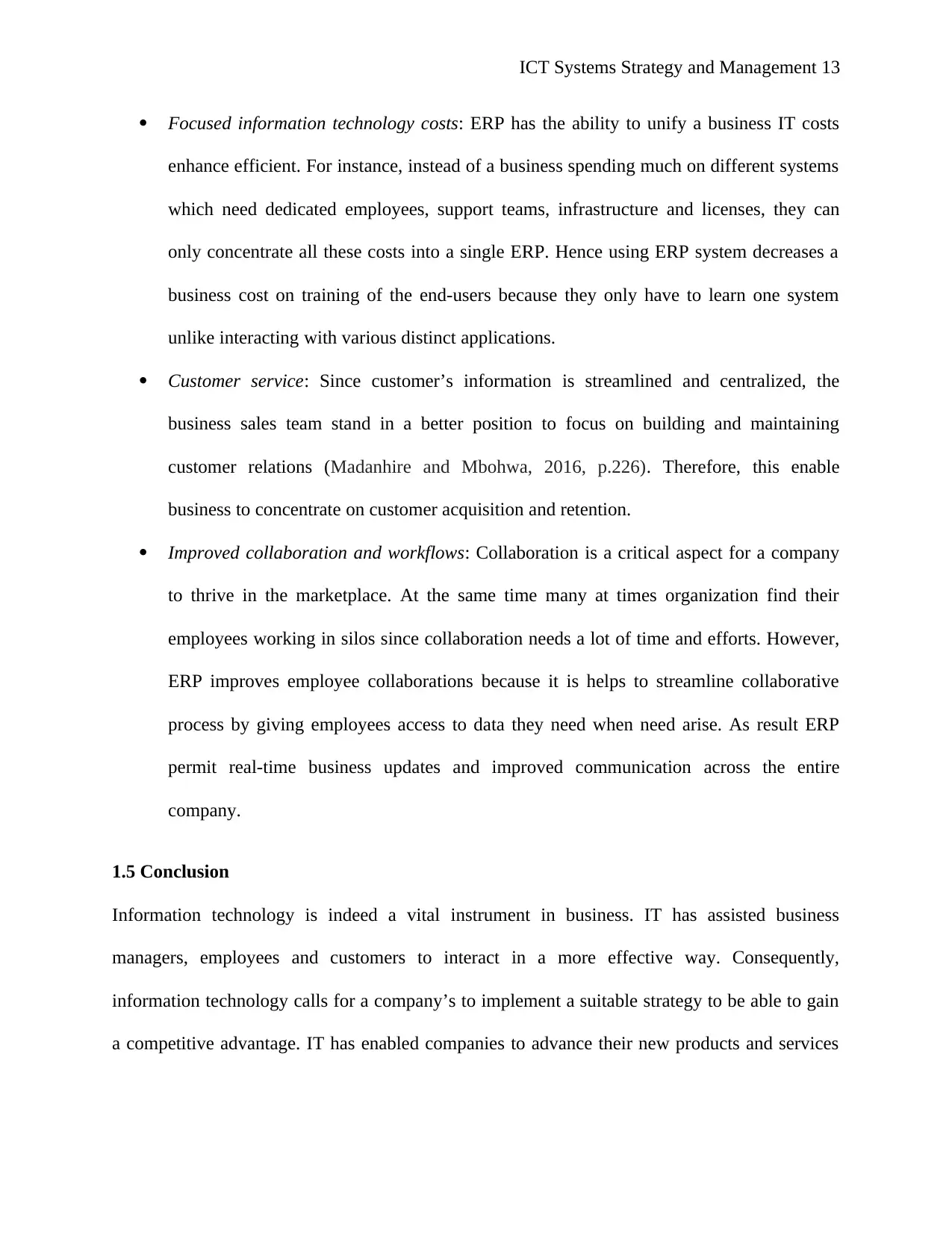
ICT Systems Strategy and Management 13
Focused information technology costs: ERP has the ability to unify a business IT costs
enhance efficient. For instance, instead of a business spending much on different systems
which need dedicated employees, support teams, infrastructure and licenses, they can
only concentrate all these costs into a single ERP. Hence using ERP system decreases a
business cost on training of the end-users because they only have to learn one system
unlike interacting with various distinct applications.
Customer service: Since customer’s information is streamlined and centralized, the
business sales team stand in a better position to focus on building and maintaining
customer relations (Madanhire and Mbohwa, 2016, p.226). Therefore, this enable
business to concentrate on customer acquisition and retention.
Improved collaboration and workflows: Collaboration is a critical aspect for a company
to thrive in the marketplace. At the same time many at times organization find their
employees working in silos since collaboration needs a lot of time and efforts. However,
ERP improves employee collaborations because it is helps to streamline collaborative
process by giving employees access to data they need when need arise. As result ERP
permit real-time business updates and improved communication across the entire
company.
1.5 Conclusion
Information technology is indeed a vital instrument in business. IT has assisted business
managers, employees and customers to interact in a more effective way. Consequently,
information technology calls for a company’s to implement a suitable strategy to be able to gain
a competitive advantage. IT has enabled companies to advance their new products and services
Focused information technology costs: ERP has the ability to unify a business IT costs
enhance efficient. For instance, instead of a business spending much on different systems
which need dedicated employees, support teams, infrastructure and licenses, they can
only concentrate all these costs into a single ERP. Hence using ERP system decreases a
business cost on training of the end-users because they only have to learn one system
unlike interacting with various distinct applications.
Customer service: Since customer’s information is streamlined and centralized, the
business sales team stand in a better position to focus on building and maintaining
customer relations (Madanhire and Mbohwa, 2016, p.226). Therefore, this enable
business to concentrate on customer acquisition and retention.
Improved collaboration and workflows: Collaboration is a critical aspect for a company
to thrive in the marketplace. At the same time many at times organization find their
employees working in silos since collaboration needs a lot of time and efforts. However,
ERP improves employee collaborations because it is helps to streamline collaborative
process by giving employees access to data they need when need arise. As result ERP
permit real-time business updates and improved communication across the entire
company.
1.5 Conclusion
Information technology is indeed a vital instrument in business. IT has assisted business
managers, employees and customers to interact in a more effective way. Consequently,
information technology calls for a company’s to implement a suitable strategy to be able to gain
a competitive advantage. IT has enabled companies to advance their new products and services
Paraphrase This Document
Need a fresh take? Get an instant paraphrase of this document with our AI Paraphraser
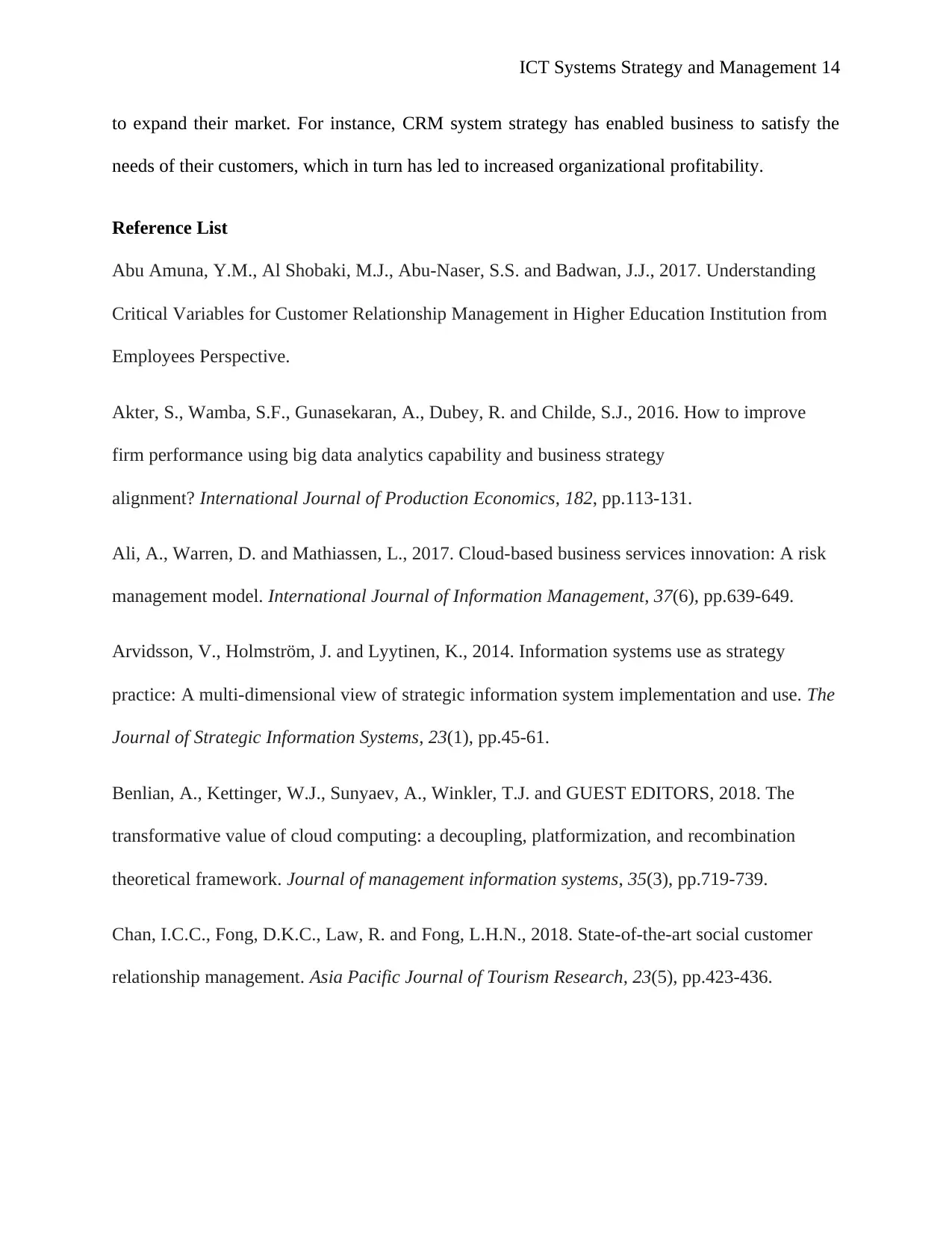
ICT Systems Strategy and Management 14
to expand their market. For instance, CRM system strategy has enabled business to satisfy the
needs of their customers, which in turn has led to increased organizational profitability.
Reference List
Abu Amuna, Y.M., Al Shobaki, M.J., Abu-Naser, S.S. and Badwan, J.J., 2017. Understanding
Critical Variables for Customer Relationship Management in Higher Education Institution from
Employees Perspective.
Akter, S., Wamba, S.F., Gunasekaran, A., Dubey, R. and Childe, S.J., 2016. How to improve
firm performance using big data analytics capability and business strategy
alignment? International Journal of Production Economics, 182, pp.113-131.
Ali, A., Warren, D. and Mathiassen, L., 2017. Cloud-based business services innovation: A risk
management model. International Journal of Information Management, 37(6), pp.639-649.
Arvidsson, V., Holmström, J. and Lyytinen, K., 2014. Information systems use as strategy
practice: A multi-dimensional view of strategic information system implementation and use. The
Journal of Strategic Information Systems, 23(1), pp.45-61.
Benlian, A., Kettinger, W.J., Sunyaev, A., Winkler, T.J. and GUEST EDITORS, 2018. The
transformative value of cloud computing: a decoupling, platformization, and recombination
theoretical framework. Journal of management information systems, 35(3), pp.719-739.
Chan, I.C.C., Fong, D.K.C., Law, R. and Fong, L.H.N., 2018. State-of-the-art social customer
relationship management. Asia Pacific Journal of Tourism Research, 23(5), pp.423-436.
to expand their market. For instance, CRM system strategy has enabled business to satisfy the
needs of their customers, which in turn has led to increased organizational profitability.
Reference List
Abu Amuna, Y.M., Al Shobaki, M.J., Abu-Naser, S.S. and Badwan, J.J., 2017. Understanding
Critical Variables for Customer Relationship Management in Higher Education Institution from
Employees Perspective.
Akter, S., Wamba, S.F., Gunasekaran, A., Dubey, R. and Childe, S.J., 2016. How to improve
firm performance using big data analytics capability and business strategy
alignment? International Journal of Production Economics, 182, pp.113-131.
Ali, A., Warren, D. and Mathiassen, L., 2017. Cloud-based business services innovation: A risk
management model. International Journal of Information Management, 37(6), pp.639-649.
Arvidsson, V., Holmström, J. and Lyytinen, K., 2014. Information systems use as strategy
practice: A multi-dimensional view of strategic information system implementation and use. The
Journal of Strategic Information Systems, 23(1), pp.45-61.
Benlian, A., Kettinger, W.J., Sunyaev, A., Winkler, T.J. and GUEST EDITORS, 2018. The
transformative value of cloud computing: a decoupling, platformization, and recombination
theoretical framework. Journal of management information systems, 35(3), pp.719-739.
Chan, I.C.C., Fong, D.K.C., Law, R. and Fong, L.H.N., 2018. State-of-the-art social customer
relationship management. Asia Pacific Journal of Tourism Research, 23(5), pp.423-436.
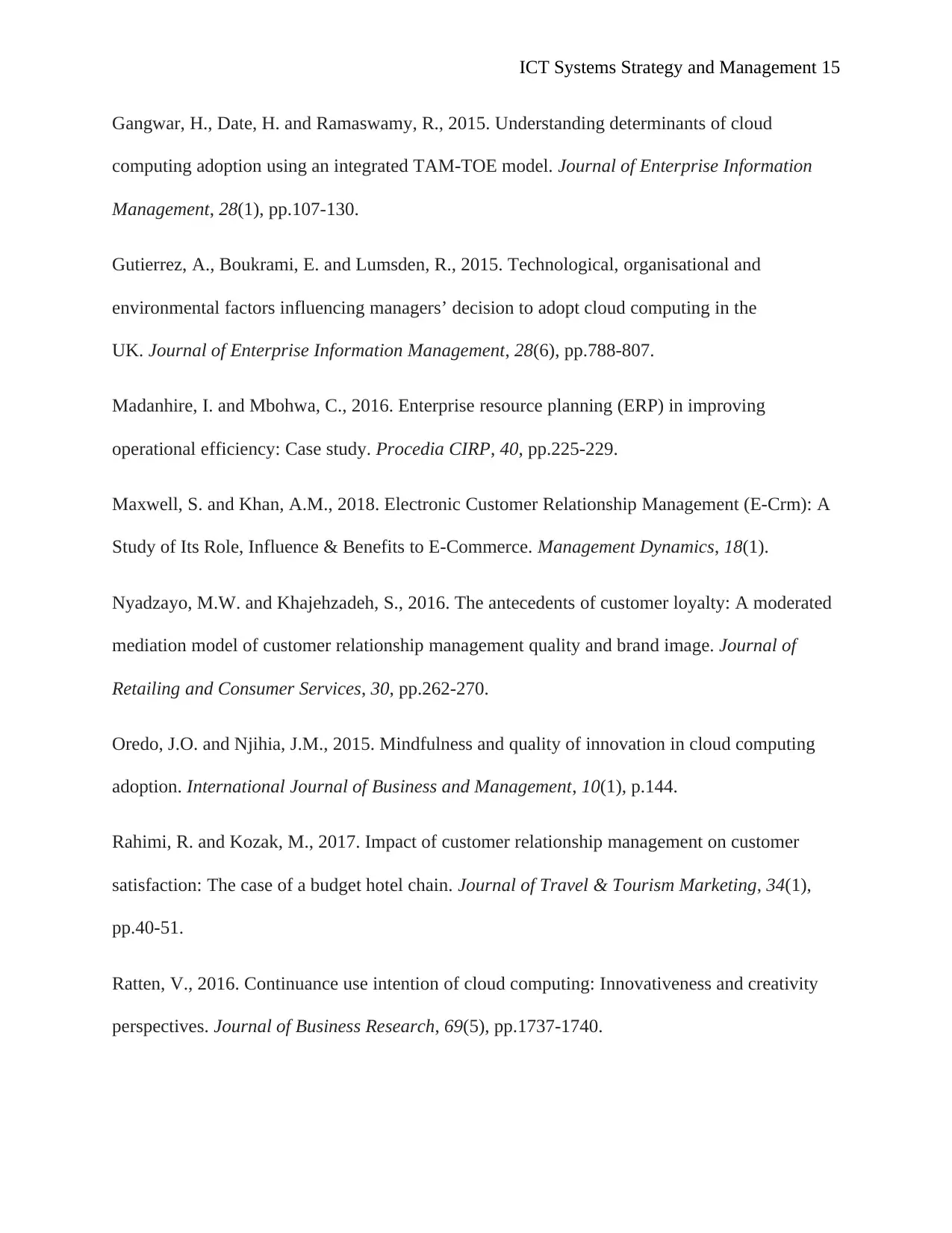
ICT Systems Strategy and Management 15
Gangwar, H., Date, H. and Ramaswamy, R., 2015. Understanding determinants of cloud
computing adoption using an integrated TAM-TOE model. Journal of Enterprise Information
Management, 28(1), pp.107-130.
Gutierrez, A., Boukrami, E. and Lumsden, R., 2015. Technological, organisational and
environmental factors influencing managers’ decision to adopt cloud computing in the
UK. Journal of Enterprise Information Management, 28(6), pp.788-807.
Madanhire, I. and Mbohwa, C., 2016. Enterprise resource planning (ERP) in improving
operational efficiency: Case study. Procedia CIRP, 40, pp.225-229.
Maxwell, S. and Khan, A.M., 2018. Electronic Customer Relationship Management (E-Crm): A
Study of Its Role, Influence & Benefits to E-Commerce. Management Dynamics, 18(1).
Nyadzayo, M.W. and Khajehzadeh, S., 2016. The antecedents of customer loyalty: A moderated
mediation model of customer relationship management quality and brand image. Journal of
Retailing and Consumer Services, 30, pp.262-270.
Oredo, J.O. and Njihia, J.M., 2015. Mindfulness and quality of innovation in cloud computing
adoption. International Journal of Business and Management, 10(1), p.144.
Rahimi, R. and Kozak, M., 2017. Impact of customer relationship management on customer
satisfaction: The case of a budget hotel chain. Journal of Travel & Tourism Marketing, 34(1),
pp.40-51.
Ratten, V., 2016. Continuance use intention of cloud computing: Innovativeness and creativity
perspectives. Journal of Business Research, 69(5), pp.1737-1740.
Gangwar, H., Date, H. and Ramaswamy, R., 2015. Understanding determinants of cloud
computing adoption using an integrated TAM-TOE model. Journal of Enterprise Information
Management, 28(1), pp.107-130.
Gutierrez, A., Boukrami, E. and Lumsden, R., 2015. Technological, organisational and
environmental factors influencing managers’ decision to adopt cloud computing in the
UK. Journal of Enterprise Information Management, 28(6), pp.788-807.
Madanhire, I. and Mbohwa, C., 2016. Enterprise resource planning (ERP) in improving
operational efficiency: Case study. Procedia CIRP, 40, pp.225-229.
Maxwell, S. and Khan, A.M., 2018. Electronic Customer Relationship Management (E-Crm): A
Study of Its Role, Influence & Benefits to E-Commerce. Management Dynamics, 18(1).
Nyadzayo, M.W. and Khajehzadeh, S., 2016. The antecedents of customer loyalty: A moderated
mediation model of customer relationship management quality and brand image. Journal of
Retailing and Consumer Services, 30, pp.262-270.
Oredo, J.O. and Njihia, J.M., 2015. Mindfulness and quality of innovation in cloud computing
adoption. International Journal of Business and Management, 10(1), p.144.
Rahimi, R. and Kozak, M., 2017. Impact of customer relationship management on customer
satisfaction: The case of a budget hotel chain. Journal of Travel & Tourism Marketing, 34(1),
pp.40-51.
Ratten, V., 2016. Continuance use intention of cloud computing: Innovativeness and creativity
perspectives. Journal of Business Research, 69(5), pp.1737-1740.
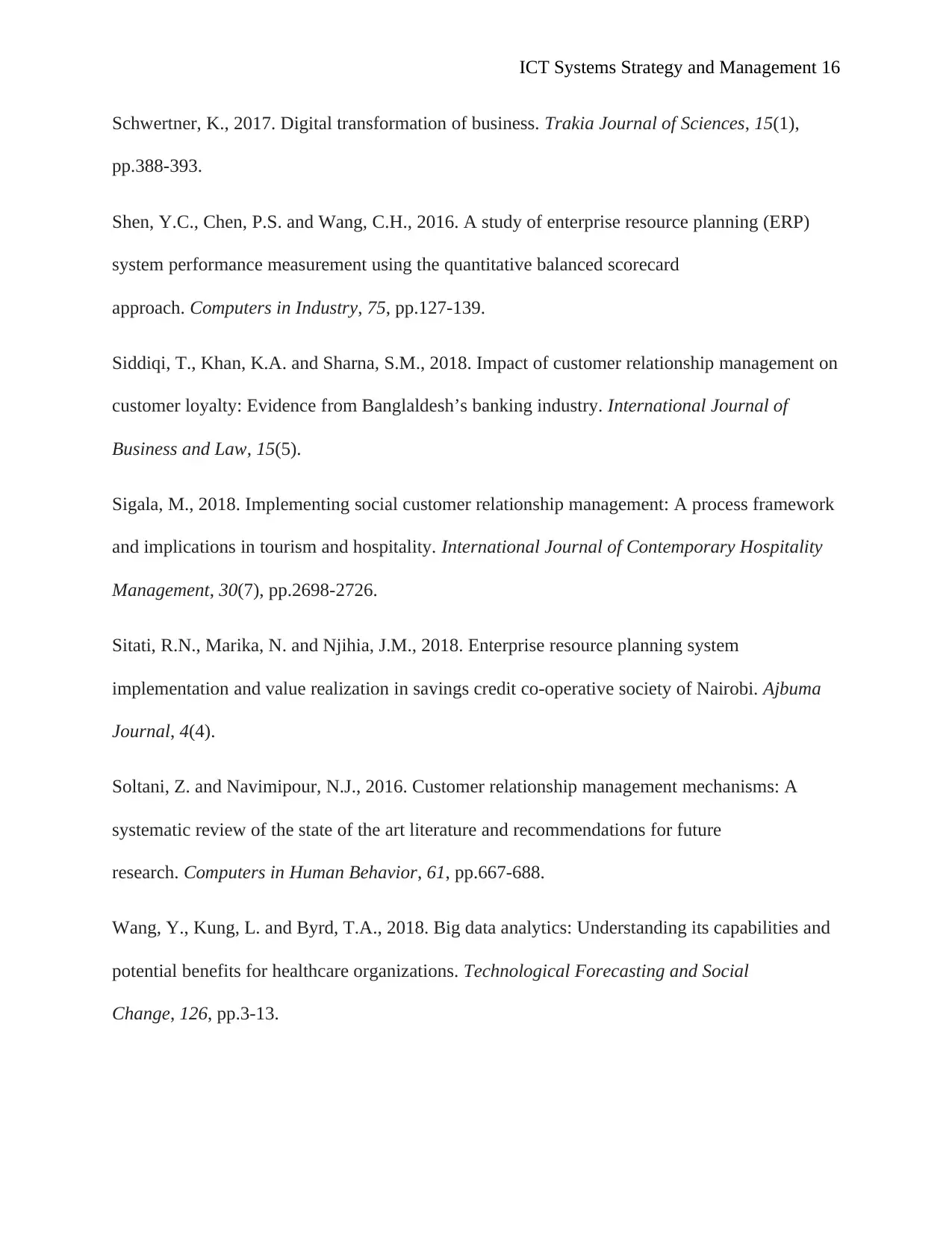
ICT Systems Strategy and Management 16
Schwertner, K., 2017. Digital transformation of business. Trakia Journal of Sciences, 15(1),
pp.388-393.
Shen, Y.C., Chen, P.S. and Wang, C.H., 2016. A study of enterprise resource planning (ERP)
system performance measurement using the quantitative balanced scorecard
approach. Computers in Industry, 75, pp.127-139.
Siddiqi, T., Khan, K.A. and Sharna, S.M., 2018. Impact of customer relationship management on
customer loyalty: Evidence from Banglaldesh’s banking industry. International Journal of
Business and Law, 15(5).
Sigala, M., 2018. Implementing social customer relationship management: A process framework
and implications in tourism and hospitality. International Journal of Contemporary Hospitality
Management, 30(7), pp.2698-2726.
Sitati, R.N., Marika, N. and Njihia, J.M., 2018. Enterprise resource planning system
implementation and value realization in savings credit co-operative society of Nairobi. Ajbuma
Journal, 4(4).
Soltani, Z. and Navimipour, N.J., 2016. Customer relationship management mechanisms: A
systematic review of the state of the art literature and recommendations for future
research. Computers in Human Behavior, 61, pp.667-688.
Wang, Y., Kung, L. and Byrd, T.A., 2018. Big data analytics: Understanding its capabilities and
potential benefits for healthcare organizations. Technological Forecasting and Social
Change, 126, pp.3-13.
Schwertner, K., 2017. Digital transformation of business. Trakia Journal of Sciences, 15(1),
pp.388-393.
Shen, Y.C., Chen, P.S. and Wang, C.H., 2016. A study of enterprise resource planning (ERP)
system performance measurement using the quantitative balanced scorecard
approach. Computers in Industry, 75, pp.127-139.
Siddiqi, T., Khan, K.A. and Sharna, S.M., 2018. Impact of customer relationship management on
customer loyalty: Evidence from Banglaldesh’s banking industry. International Journal of
Business and Law, 15(5).
Sigala, M., 2018. Implementing social customer relationship management: A process framework
and implications in tourism and hospitality. International Journal of Contemporary Hospitality
Management, 30(7), pp.2698-2726.
Sitati, R.N., Marika, N. and Njihia, J.M., 2018. Enterprise resource planning system
implementation and value realization in savings credit co-operative society of Nairobi. Ajbuma
Journal, 4(4).
Soltani, Z. and Navimipour, N.J., 2016. Customer relationship management mechanisms: A
systematic review of the state of the art literature and recommendations for future
research. Computers in Human Behavior, 61, pp.667-688.
Wang, Y., Kung, L. and Byrd, T.A., 2018. Big data analytics: Understanding its capabilities and
potential benefits for healthcare organizations. Technological Forecasting and Social
Change, 126, pp.3-13.
Secure Best Marks with AI Grader
Need help grading? Try our AI Grader for instant feedback on your assignments.

ICT Systems Strategy and Management 17
Wang, Z. and Kim, H.G., 2017. Can social media marketing improve customer relationship
capabilities and firm performance? Dynamic capability perspective. Journal of Interactive
Marketing, 39, pp.15-26.
Wang, Z. and Kim, H.G., 2017. Can social media marketing improve customer relationship
capabilities and firm performance? Dynamic capability perspective. Journal of Interactive
Marketing, 39, pp.15-26.
1 out of 17
Related Documents
Your All-in-One AI-Powered Toolkit for Academic Success.
+13062052269
info@desklib.com
Available 24*7 on WhatsApp / Email
![[object Object]](/_next/static/media/star-bottom.7253800d.svg)
Unlock your academic potential
© 2024 | Zucol Services PVT LTD | All rights reserved.





